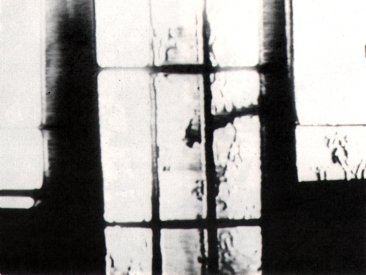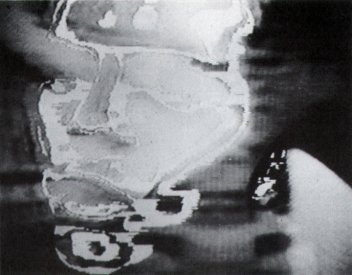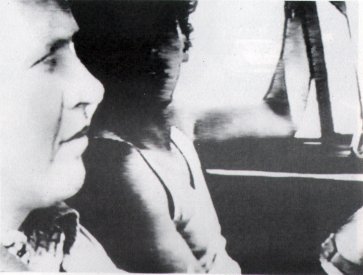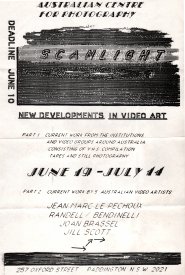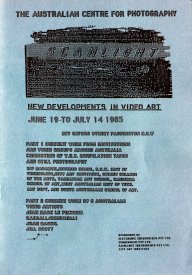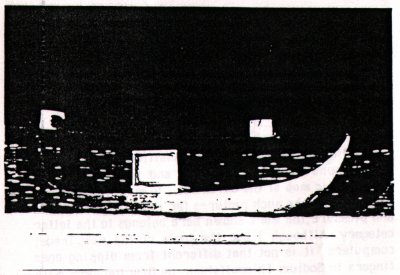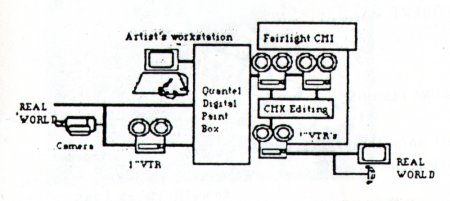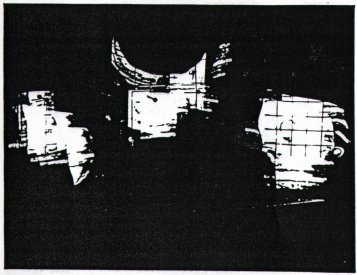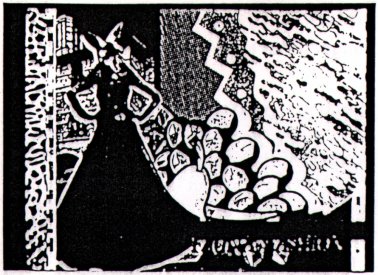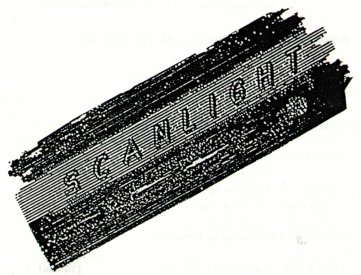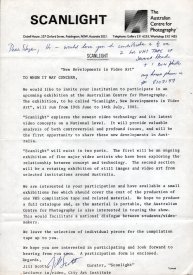In 1985 the video scene in Sydney had reached a point where there were enough people making video works - whether art, documentary, video music or computer graphic - to begin to make it important and possible to have a collective show of recent works.
Jill Scott who had recently returned to Australia after having lived in San Francisco for many years and establishing her name in performance and video art, got together with Martin Jolly at the Australian Centre for Photography to develop this event. It was, in many ways, a mini-festival of recent work made by several of the early video artists and being encouraged through video courses in the Art Schools.
Wendy Spencer came on board to production manage the exhibition. She also prepared the catalogue.
[Below is the Catalogue. It is slightly re-ordered and has been corrected for typographical errors - SJ]
SCANLIGHT
New Developments in Video Art, June 19 – july 14, 1985,
Australian Centre for Photography
FRESH VALUE
The nature of video art production & presentation in Australia infers a strange isolation from the art world, an audience and between the artists themselves. We recognise the need for video art to be enjoyed and critically examined and now a diverse body of artists and audience are beginning to realise new possibilities and directions for the medium. By presenting a collection of recent works from five artists who were selected for their reputation and endurance, and the work of other prominent video groups and students; the diversity and concerns of video art in Australia becomes apparent. Just as importantly most of the video artists whose work is featured will attend the reception offering new opportunities for dialogue.
Video is an attractive medium, offering many manipulative components; colour, sound, recording, post-production and viewing, interventions and additions of and to the image during the process of performance. Also its software possibilities, the interface with most other visual, aural and performance arts, its position within the context of television and its exhibition and distribution potentials. With so many tools at one’s disposal, it is not surprising to witness the diversity of approaches and products presented by SCANLIGHT. It is also astonishing to discover that the public finds video a difficult medium to analyse. With SCANLIGHT, one witnesses the seeds of an emerging force to be reckoned with as video art establishes a higher profile within a dynamic independent video industry.
Joan Brassil's work is concerned with landscape as sculpture. She approaches video entirely as an installation component. For her video is a translucent ephemeral medium giving kinetic value to basic biological life-forms. By using layering video wipes f/x and still photography of biological structures her video material is a source for producing light patterns reflected on glass structures, in effect producing a panoramic landscape that frees the viewer and the work from the containment of the "TV BOX".
Mesmerization and landscape relocation are important also for Jill Scott. This sequel to Doubledream (her last video) attempts to rewrite history by using Fantasy and Science Fiction to oppose ‘TV Fact’.
Magnificent Desolation provides an alternative to the representation and the perception of women we find in TV, and that "actually, when Armstrong landed on the moon in 1967, there was a women there before him". Jill Scott has managed to subvert our images by extensive use of chroma-key, Macpaint and Fairlight’s CVI & CMI to produce her work. Interestingly she chooses to hide the hardware and deny the existence of the TV BOX.
Here we see video art as a sculptural object suitable for a Gallery as well as the video tape itself being used as a critical tool to examine its most familiar incarnation, broadcast television, and the television images we have all come to think and be. A progression can be seen in Scott’s work that links traditional approaches to video art through to a critical process of subverting television myths to a fairly obvious attempt to create her own myths.
From the early seventies Black/White 1/2" concepts of ‘mucking around’ with the medium, video art has grown into a sophisticated form and is now progressing through a post-modernist critical de-construction and evaluation of television, addressing its audience and confidently producing a diversity of experimental television.
The News made by →↑→ empties television news presentation by recreating through cut-up
montage repetition and wipes, lifeless faces without bodies, expressions of picture:s that present us with ‘knowledge’ as a landscape of mirages and collapsing visual structures. Their sound is a distorted mix of new sound, a comfortable drone that effectively questions the value and reception of knowledge.
While →↑→ empties television, Robert Randall and Frank BendInelli have consistently managed to sell their criticism back to us, the ‘processed public’. They make extensive use of chroma-key, simplified dialogue and visual elements to de-construct soapies and love stories, while simultaneously constructing densely loaded segments of popular TV culture. Could this work be a smash on commercial television?
In 1984, Jean Marc le Pechoux, (originally a photographer) opened the Video Paintbrush Company and invited the Randelli artists to contribute. Using the Quantel Paintbox (an elaborate video graphic computer), they designed a segment of the work for this exhibition. Jean Marc has already worked extensively with chroma-key using synthetic computer landscapes similar to those used in the film Tron. His work in SCANLIGHT is composed on the Paintbox, and consequently it addresses the shrinking of the barriers between Fine art and Video.
SCANLIGHT displays evidence that artists are part of the video industry and are beginning to address an audience and are producing new television. It is now conceivable to talk about a market for video art as it has helped to feed and create the independent industry and can no longer be seen as an alien indulgence linked to an elitist art world. The nature of video demands access to expensive hardware facilities end specialist skills. With limited arts funding, video artists have attached themselves to teaching institutions or, for the tenacious, to the industry and often to the point of building their own facilities. Funding from the Visual Arts Board and the Australian Film Commission is lacking. Until it's market is realised, the potential of video art and the support it can give to an independent video/television industry will be unfortunately unrecognised and the means for its existence will be constantly eroded.
Recent developments however, show that artists may have innovative and necessary marketing strategies already. Jill Scott has established relationships with Fairlight Instruments and Ultra Art; the Randellis with the AFC and The Video Paintbrush Company which is owned by Jean Marc; Joan Brassil with John Baird’s Facilities; Severed Heads have set up their own video facility; Zip Magazine is looking into collaborations with Brisbane video industries; and the Schools represented in SCANLIGHT are interested in collaborating with each other.
SCANLIGHT and exhibitions like it highlight the tremendous potential and interest in the survival of video art and the realisation that a market can and must be addressed. We hope that you will enjoy the variety of fresh approaches by the growing number of tertiary students represented in SCANLIGHT who are interested in establishing a dialogue through exhibitions such as these, where producers can overcome isolation so alien to the medium itself.
Wendy Spencer, Claudine McMundi
[Our apologies to Peter Callas for not being included in SCANLIGHT, funding would not allow him to visit from Japan. We gratefully acknowledge the organisation he has contributed to Australian video.]
[Artists in the exhibition were:]
→↑→
THE NEWS, Made by →↑→
Even though the media appears to have a pervasive yet monolithic presence, its dimensions are difficult to specify; as unfelt as printed ink or transmitted airwaves. Through misreading the Media as an holistic body or a full construction, analytic dissections inevitably leave us with quivering members and collapsing structures - unable to explain the effect of the media, capable only of reflecting its mirages. In such a landscape of mirages and dried up wells of analysis live the news; telling us everything and nothing, full of fact yet fraught with friction. Truth is of no concern here because the News only uses truth as a driving principle for all the aspirations, conflation and collusions which make up its coverages. There is nothing ‘between the lines’ in the News - and THE NEWS is about that nothing.
- SELECTED EXHIBITIONS
→↑→ have been shoving extensively since 1976 both in Australia and Oversees as a video, sound and graphic group.
JEAN MARC LE PECHOUX
IF THEN. (5 mins.)
If Then represents a transition from taking Photographs (with a capital P) and belonging to the Photographic mob of the Seventies, to making narrative pictures. I make such pictures for industry, commerce and pleasure, the work shown here belongs to the latter category. Although I use the tools of the new trade; computers, it is not that different from dipping ones fingers in Sodium Thiosulfate or De Beering away with a cold (cathode) head. Video computer graphics give visual artists a greater amount of control in the presentation of their work, all I guess, for the sake of simplified communication. Now it is a fact, you cannot trust television, some of the images presented here are a cross between facial surgery and disfiguration of the Truth; done with a machine (the Brilliant Quantel Paint Box) which plugs into just about every T.V. station in the world. The original images are photographs that I took years ago with the innocent eye of an adolescent discovering the world, now surrounded by machine technology, I increasingly feel the urge to bring back to my world the textures and emotions of the real world. This tape steps in that direction.
- BACKGROUND
Photography, photojournalism, Audiovisual production
Editor - Light Vision Magazine.
Exhibitions in Melbourne, Sydney, Canberra.
Advisor to Preston’s Media Arts Degree course, Studied Computer Animation, Swinburne
- CURRENT
Director - Video Paint Brush Company, Melbourne.
JILL SCOTT
MAGNIFICENT DESOLATION
This work is a sequel to Doubledream an earlier tape composed of two opposing forces. ‘HOT and COLD’. It was based on a reaction to McLuhan who regarded T.V. essentially as a Cold (i.e. leaves little to the imagination) medium. In Doubledream the Hot woman and the Cold women are separated and the choice is the viewer's preference, however there are seductive mesmeric qualities to both. In Magnificent Desolation the Cold woman is living on the Moon when the Americans land accompanied by Hot music and in the end fades back onto the earth her symbol lost forever.
SELECTED EXHIBITIONS
- SOLO:
1977 Video Free America, San Francisco:
1978 San Francisco Museum of Modern Art:
1979 The Franklin Furnace, New York:
1980 Los Angeles Institute For Contemporary Art:
1981 London Video Arts:
1982 Internationaal Cultreel Centrum. Antwerp:
1983 Roslyn Oxley Sydney:
1984 Heidelberg Kunstverein, West Germany:
1985 Performance Space, Sydney
- GROUP
1971 New Directions in Video, Cockpit Theatre London:
1976 Artist's Tapes Marin Cablevision, California:
1979-80 Various Video Tours. America & Australia:
1982 Selected Video, The Kitchen New York:
1983 Anzart; Continuum:
1985 Anzart; Vienna Video Festival; An Australian Tour in England.
ROBERT RANDALL AND FRANK BENDINELLI
FAUNA FASHIONS:
*All animals are equal, but some are better dressed than others." Randelli. March 1985.
A TAXI TO TEMPTATION.
The story of Vivien Leigh, a fragile neurotic school teacher given to the affectations of morality and gentility, who flees her hometown to come and live with her sister in New Orleans.
The sister has thrown off the dreamy memories of the past and is married to a muscular young Marlon Brando. But Ann Margaret, attempting to hold onto her unreal earlier days, provokes Treat Williams into searching out and revealing her more intimate past. After some taunting Adam Boyd forces himself onto Jill Scott and makes love to her.
“Whoever you are, I have always depended on the kindness of strangers. Wham bam thank you ma’am.”
Randelli, June 1985.
SELECTED EXHIBITIONS.
- SOLO Exhibitions since 1977, 81:
Reconnaissance Gallery, Melbourne; Sixto Notes, Milano, Italy; Air Gallery, London; Video Bank, Holland; A>R>C> Gallery, Toronto, Canada; Western Front, Vancouver, Canada; Studentski Kulturni Centar, Belgrade, Yugoslavia; Australian Centre for Contemporary Art. Melbourne.
- GROUP
Videotapes from Australia, the Kitchen New York; Biennale de Paris, Museum of Modern Art, Parts; Perspecta, Sydney; Sydney Biennale, Sydney; Continuum’83, Japan; Interface, Adelaide; Anzart, Auckland; Isoaustralia, Italy.
JOAN BRASSIL
STRANGER CHARTING. Video Sculpture.
In the early charting of Australia the images perceived by the stranger could not be clear as they had no reference in memory. The clarification, by charts and grids, records the contours, but the landscape of another culture is elusive as the transparent still images dissolving into video, then from video to reflections. The reflections move distortedly on perspex behind static wire grids. [Brassil.]
Didgeridu - Stewart Whittlestone;
Viola - Anita Beuthien.
Artist - Joan Brassil;
Video Camera - John Baird.
SELECTED EXHIBITIONS
- SOLO:
1975 Bonython Gallery, Sydney.
1976 Sculpture Centre, Sydney.
From 1982-1985 four exhibitions at Roslyn Oxley Gallery, Sydney.
- GROUP.
1979 Festival of Sydney,
1981 First Australian Sculpture Triennial, La Trobe, Victoria;
1983 Zona Gallery Italy.; Paretaio Italy;
1985 Artists Glass Works, Craft Council, Sydney.
ZIP
ZIP is a intermedia group from Brisbane whose main contributors; Tim Gruchy and Terry Murphy, produce an abundance of Audio, Video and Graphic components. They montage distort and re-create using synthetic effects, paste up, text and wire spaghetti generating patterns.
ZIP VIDEO NO 1.
A. 1-2-1;
B. One Ddub.
C. We all Know.
D. Lab D'Avoid.
E. Projects No 3.
SEVERED HEADS
produced by Heuristic Video.
1. Goodbye Tonsils
2. Petrol
3. Lower Than the Grave
4. Dead Eyes Opened
5. Kato Gets The Girl
[STUDENT COMPILATIONS]
CITY ART INSTITUTE, SYDNEY
Compiled by Isao Kimura, photos Barber& Dowling.
1. Temptation, Tracy Barbe
2. Romantic Love, Tracy Barbe, Owen Edwards
3. Old, Steven Ormandy
4. Family Familiar, Anna Schneiderman
5. Pivot Point, Barbra DowIing
6. Heart and Orders, Isao Kimura
7. Parallel, Isao Kimura
8. The Truth About Lemon Bon Bons, Owen Edwards
9. Danger on the Rocks, George Evatt
10. G>P>I, Barbara DowIing
11. Untitled, Eddy Jokovich
|12. Fifi et Claude, Susie Mudronja
City Art Institute also has a separate VHS tape with a group project called T.V.I.Q.
T.V.I.Q is a poem clip made by the Advanced Video Class.
CANBERRA SCHOOL OF ART
Compiled by Veet Sandeh.
1. Summer
2. Drains
3. Woman
4. Little Boy
5. Cowboys
6. Duality
WEST AUSTRALIAN INSTITUTE OF TECHNOLOGY, SCHOOL OF ART AND DESIGN.
1. Imagine, Ian Beattie
2. Rocks and Water, Stephen Bourke
3. Intermission, Thomas Kayser
4. Swampland, Ian Underwood
5. Maze, Julie Lygne
6. Lizard Man, Martin Tabor
TASMANIAN SCHOOL OF ART. HOBART
Countdown Leader, Barbara Robertson
1. 2 Installations, Chris Undy, (1.30 min)
2. Torso, Peter Williamson, (6.07 min)
3. Lebanon/Beirut, Ismet Jesenkovic, (8.58 min)
4. In Paint, Janet Clark, (12.29 min)
5. War/Real Life Fantacies/Wave Drone, Sharon Heritage, (18.29 min)
6. Kate and Bill, Richard Williams, (28.27 min)
7. Justice, Jenny Forward, (33.37 min)
8. Dolly Mixture, Chris Hewitt, (38.53 min)
9. Untitled #1 & #2, Gabrille Armstrong, (45.35 min)
10. Installation, Construction by Greg Bell, (55.00 min)
11. Lighthouse From Landscapes Series, Leigh Hobba, (1 hour 40 min)
NEW SOUTH WALES INSTITUTE OF TECHNOLOGY, FACULTY OF HUMANITIES AND SOCIAL SCIENCES, COMMUNICATIONS DEPARTMENT.
VIDEO PROGRAM "DRAMATIC SITUATIONS"
1. Witches, Kathy Drayton & Nikki Perrin., (4 mins)
2. The Screening, Megan Heywood, Kristan Dunph, Margaret Lupton, (12 mins)
3. Generic Women, K. Mumford, (5 mins)
4. Four Girls, Linda Wallace, (10 mins)
5. Happy Story, Michael Ross, Jeff Tsui, Andrew Litchfiteld, (5 mins)
6. Mouths, Julia Tresidder, (9 mins)
7. Out of the Ashes, Mary Ann Hamilton, Maureen Burn, Lauren McKenzie, Dianna Pritchard, Jenny Bruce, (10 min)
SOUTH AUSTRALIAN COLLEGE OF ADVANCED EDUCATION.
1. Dogs and Swine, R. Bullock
2. Fugue, C. Russo
3. Bullet In, P. Lanzilli
4. Terra Nullius, C. Russo
5. Diagram, D. Lions / J. Paplow
6. Mermaid, R. Martin
7. Embrace, J. Paplow
SYDNEY COLLEGE OF THE ARTS,
VHS DUB, Cathie Vogan
